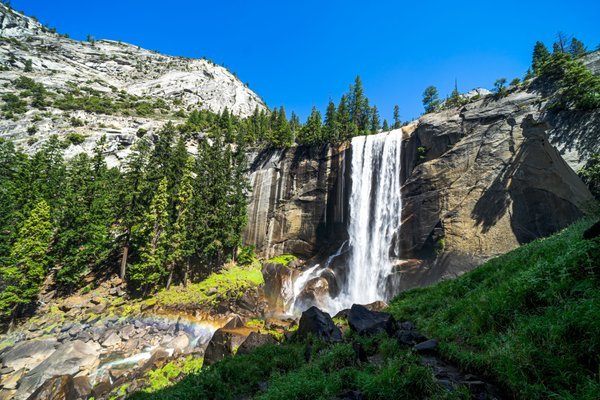
Hidden deep in the heart of California’s Sierra Nevada Mountains lies a place that defies imagination and leaves even seasoned travelers in awe: Yosemite National Park. This majestic land, protected for over a century, is a symphony of natural wonders. With cascading waterfalls that thunder down sheer granite faces, ancient forests where giant sequoias stand like guardians of time, and towering cliffs that rise like cathedrals to the sky, Yosemite is more than just a park—it is nature in its most sublime and powerful form.
Spanning nearly 1,200 square miles, Yosemite is a vast wilderness that offers something for everyone. From serene meadows and mirror-like lakes to dramatic vertical walls and alpine highlands, every inch of the park tells a story of geologic forces, ancient ecosystems, and the awe-inspiring power of natural beauty. Let us embark on an immersive journey through this natural wonderland where every step is a testament to the majesty of the wild.
The Iconic Granite Giants: El Capitan and Half Dome
The granite cliffs of Yosemite Valley are among the most iconic natural landmarks in the world. Rising over 3,000 feet (914 meters) from the valley floor, El Capitan is the largest exposed granite monolith on Earth. Towering, smooth, and impossibly vertical, this formidable rock formation is both a symbol of geologic grandeur and a mecca for rock climbers.
To the east, Half Dome emerges like a crescent moon carved into the earth. Its smooth, rounded front and sheer vertical back create a dramatic silhouette that has captured imaginations for centuries. Climbing to the summit via the Half Dome Cables Route is one of Yosemite’s most famous and challenging adventures, offering panoramic views that reward the brave.
These granite giants were formed millions of years ago by molten rock that slowly cooled beneath the Earth’s surface. Over time, glaciers carved and shaped the rock, creating the dramatic features we see today. Their silent presence dominates the landscape, providing both inspiration and perspective.
The Power and Beauty of Yosemite’s Waterfalls
Yosemite is a sanctuary for waterfalls, especially during the spring melt when snow from the high Sierra rushes down the cliffs in dazzling displays of movement and mist. The most famous of these is Yosemite Falls, which at 2,425 feet (739 meters) is one of the tallest waterfalls in North America.
Yosemite Falls is actually three waterfalls in one: Upper Yosemite Fall, the middle cascades, and Lower Yosemite Fall. The sound of rushing water echoes across the valley, and the mist from the falls can be felt long before the water is seen. In the early morning light or the golden hue of sunset, the falls seem to shimmer like silver ribbons threading through the granite walls.
Another awe-inspiring cascade is Bridalveil Fall, located near the entrance of the valley. With a height of 620 feet (189 meters), it gets its name from the delicate veil-like appearance created by wind-blown spray. According to local Native American legend, inhaling its mist brings good fortune in marriage.
Vernal Fall and Nevada Fall, located along the Mist Trail, are equally mesmerizing. Hikers ascending this trail are rewarded with up-close encounters with roaring water, verdant landscapes, and rainbows forming in the spray—a multisensory experience that brings you into the very heart of Yosemite’s elemental forces.
The Ancient Guardians: Giant Sequoias of Mariposa Grove
Among the most humbling experiences in Yosemite is walking beneath the towering giant sequoias in the Mariposa Grove. These colossal trees, some over 3,000 years old, are among the largest living organisms on the planet by volume. Reaching heights of over 250 feet (76 meters) and with trunks that span 30 feet (9 meters) in diameter, they are a living testament to time, resilience, and the quiet power of nature.
The Grizzly Giant, one of the grove’s oldest and most celebrated sequoias, is estimated to be more than 1,800 years old. Its twisted, massive branches stretch outward like ancient arms embracing the sky. Walking through the grove’s misty, fern-carpeted paths, one cannot help but feel a deep reverence for the endurance of these trees, which have withstood fire, storm, and drought for millennia.
Sequoias thrive in the moist, elevated regions of Yosemite, and their thick, fire-resistant bark and shallow root systems are marvels of evolutionary adaptation. Visiting these groves is not merely a sightseeing experience—it is an encounter with living history.
Diverse Ecosystems and Rich Biodiversity
Yosemite’s staggering diversity of landscapes supports an equally diverse array of life. From alpine meadows and oak woodlands to glacier-fed lakes and subalpine forests, the park is home to more than 400 species of vertebrates, including black bears, mule deer, bobcats, mountain lions, and over 250 species of birds.
One of the most rewarding sights is the delicate and rare Sierra Nevada bighorn sheep, which can sometimes be spotted along high rocky ridges. The park also hosts an abundance of butterflies, frogs, and other small creatures that contribute to its ecological richness.
Spring and early summer are the best times for wildflower lovers. Fields of lupine, Indian paintbrush, and Mariposa lily blanket the meadows in vibrant hues. Meanwhile, tranquil locations like Tuolumne Meadows and Tenaya Lake offer quiet spots for observing nature in its gentler forms.
Seasons of Yosemite: A Year-Round Wonder
Each season brings a new face to Yosemite. In spring, melting snow gives life to rivers and waterfalls. Summer is the peak season, drawing visitors to explore trails, scale granite walls, and camp beneath the stars. Autumn transforms the park with a golden palette as dogwoods, maples, and oaks change color. The crisp air and fewer crowds make it an ideal time for solitude and photography.
In winter, Yosemite becomes a peaceful, snow-draped sanctuary. Badger Pass Ski Area, one of California’s oldest ski resorts, offers skiing and snowboarding, while snowshoeing and cross-country skiing open up otherwise hidden corners of the park. The sight of El Capitan and Half Dome capped with snow, with wisps of clouds swirling around their peaks, is nothing short of magical.
Native American Heritage and Cultural Significance
Long before it became a national park, Yosemite was home to the Ahwahneechee people, a Native American tribe with deep spiritual and cultural ties to the land. The name “Yosemite” is believed to be derived from the Miwok word “uzumati,” meaning “grizzly bear.”
The Indian Village of Ahwahnee, near the visitor center, offers insights into their traditional way of life, including bark dwellings, acorn grinding stones, and ceremonial structures. Their stories, songs, and spiritual practices are an integral part of the park’s heritage and a reminder that Yosemite is not just a natural wonder, but also a sacred place.
Adventure and Exploration
Yosemite is a paradise for outdoor enthusiasts. The park’s 800 miles of trails cater to all skill levels, from easy loops through meadows to strenuous backcountry treks. The John Muir Trail, named after the legendary conservationist, begins in Yosemite and stretches over 200 miles through the High Sierra.
Climbing, too, is a major draw. El Capitan’s The Nose route is world-famous, and the park remains at the forefront of climbing history with feats such as Alex Honnold’s free solo ascent.
For those seeking serenity, stargazing in Yosemite is an unforgettable experience. Far from city lights, the night sky here bursts with stars, planets, and the occasional meteor. The Milky Way stretches across the sky like a celestial river—a reminder of nature’s vastness and beauty.
Conservation and the Legacy of Preservation
Yosemite is more than a national park—it is a symbol of the American conservation movement. Thanks to the advocacy of John Muir, Yosemite became one of the first places in the world to be protected for its natural beauty, laying the foundation for the national park system.
Today, preserving its ecosystems remains a priority. Park rangers and scientists work to manage fire, protect endangered species, and educate visitors about sustainable tourism. By visiting responsibly, travelers become part of Yosemite’s living legacy, helping to ensure that its wonders endure for generations to come.
Final Reflections: Nature’s Cathedral
In Yosemite, the earth speaks. It speaks through the rumble of waterfalls, the silence of ancient trees, the echo of wind against granite, and the soft crunch of pine needles underfoot. It is a place where time stretches out, not in seconds, but in millennia—where each element of the landscape, whether stone, water, or wood, tells a story of transformation, resilience, and awe.
To experience Yosemite is to rediscover wonder. Whether you’re gazing up at El Capitan’s sheer face, standing in the mist of Yosemite Falls, or simply sitting beneath a giant sequoia, you are reminded of something greater than yourself—a sense of connection to the planet and its timeless rhythms.
For travelers seeking not just beauty, but meaning, Yosemite is not just a destination. It is a sanctuary of the soul.


